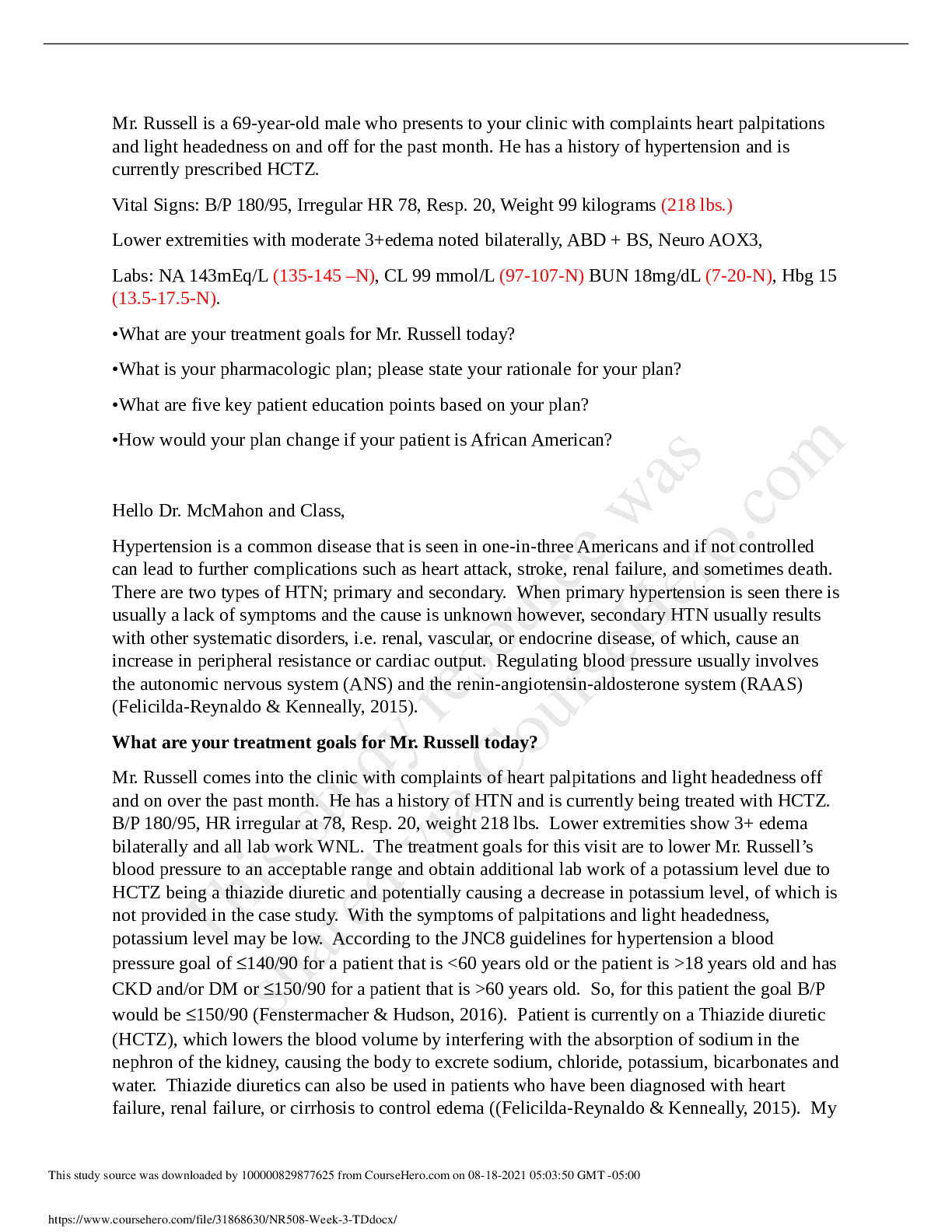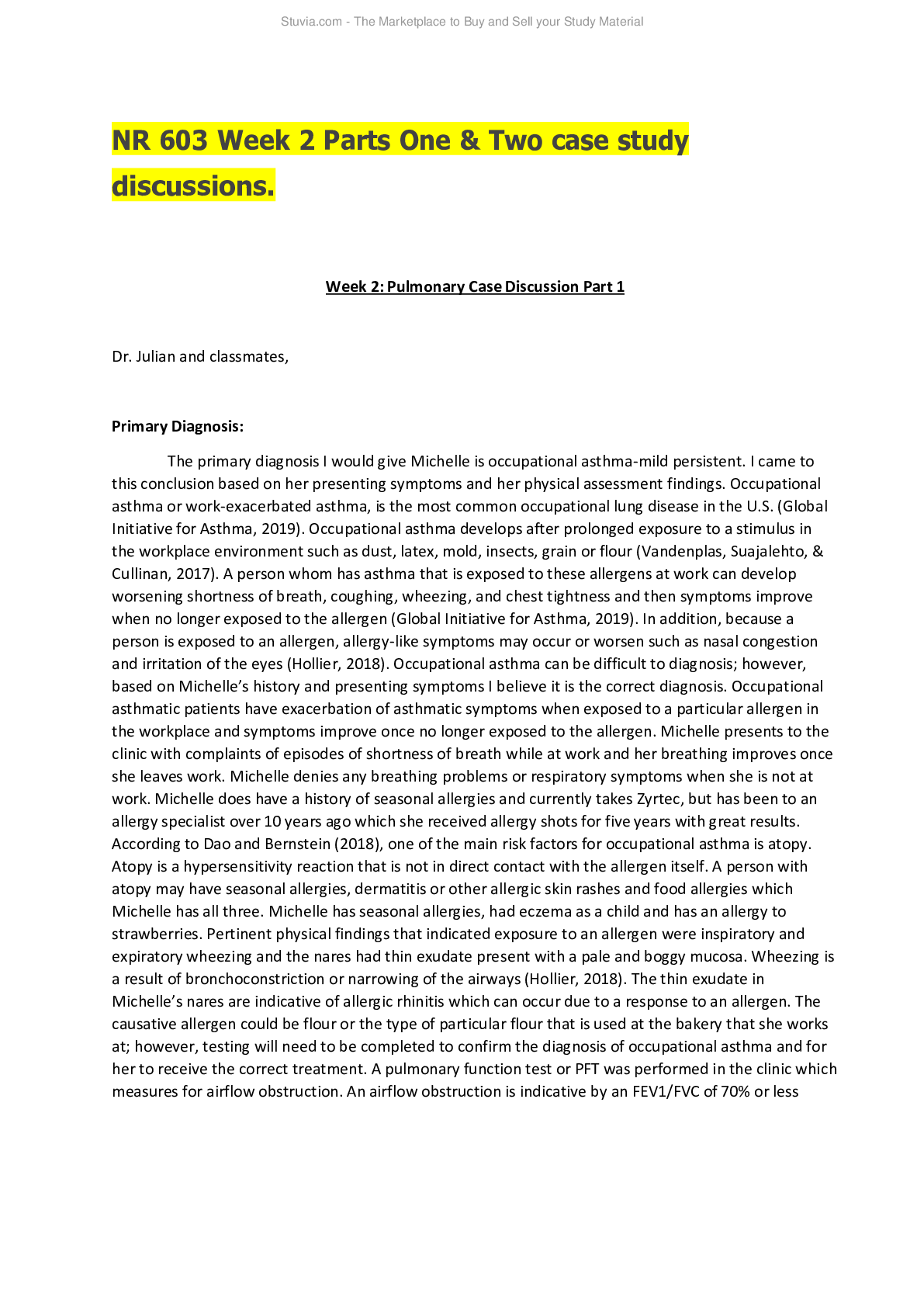*NURSING > CASE STUDY > NR 228 Case Study Discussion 6 LATEST COPY (All)
NR 228 Case Study Discussion 6 LATEST COPY
Document Content and Description Below
Jordan is a 14 year old middle school student, weighing 275 pounds and is 5’6” tall. Over the past 2 years, he has gained 60 pounds, as he has begun to withdraw from social activities, and avoid... other students, due to bullying from others his age about his weight/appearance. Lately, Jordan has been missing a great deal of school too, particularly on the days he has gym. Jordan’s parents are both average in height and weight, and Jordan’s mother says that he just takes after his grandfather William, who “was a husky man, and died of a sudden heart attack at the age of 44”. She says “We just have fat genes in the family; you can’t do anything about that”! He has been told he had “no willpower, or is weak, or that he needed to change his lifestyle, eat less and exercise more.” Jordan says “I go for a couple days without eating, but then I get so hungry that I could eat the couch”! Jason has recently been diagnosed with gallbladder disease and has symptoms that typically occur after eating that include mild pain in the mid-epigastric region, radiating to the right upper quadrant of the abdomen and right subscapular area of the body. You are the nurse assigned to Jason. 1. What would you include in your initial assessment data based on the scenario provided? The first thing I would do would be confirm the diagnosis with an ultrasound scan. I would also assess his diet and physical activity. I would ask him to keep a diet and exercise journal so that I could assess this more closely on the follow-up visit. 2. What would you teach Jordan based on the RDA Recommended Daily Allowance from the choosemyplate.gov link discussed in lesson 1, and the information provided about gallbladder disease provided in lesson 6? I would teach him not to try to lose weight too quickly because that can exacerbate the issue. Next, I would help him plan a diet that includes a lot of fibrous foods, like oatmeal and brown rice, and healthy fats, like the kind you get from fish and olives, because they are beneficial to the gallbladder by increasing contraction. I would also encourage him to eat less sugar and refined grains. 3. Based on your assessment data and the information from the scenario what might be two high priority Nursing Diagnosis to guide Jason’s plan of care? The highest priority would be changing his diet to improve gallbladder function and decrease his chances of developing cholelithiasis. Secondly, I would encourage exercise, which will improve his physical health and also decrease his chances of developing cholelithiasis. References Grodner, M., Roth, S. L., Walkingshaw, B. C., & Grodner, M. (2012). Nutritional foundations and clinical applications: A nursing approach (6th ed.). St. Louis, MO: Mosby/Elsevier. US National Library of Medicine. (2016, September 28). Gallbladder Diseases: MedlinePlus. Retrieved from https://medlineplus.gov/gallbladderdiseases.html I just realized that I put interventions instead of diagnoses. Deficient knowledge RT information misinterpretation as AEB inappropriate health maintenance and improvement behaviors. I would include this because he seems to understand that obesity adds to his problem, but he is not handling it correctly with a good diet and exercise. Instead, he’s trying to starve himself, which will exacerbate his issues. Anxiety RT a threat to self-concept AEB diminished productivity and apprehensive, distressed behaviors. I would include this because he is missing school and scared of bullies. References Ralph, S. S., & Taylor, C. M. (2011). Sparks and Taylor's nursing diagnosis pocket guide (2nd ed.). Philadelphia, PA: Wolters Kluwer/Lippincott Williams & Wilkins Health. 1. Assess whether nutritional intake provides basic nutrients for optimal health and wellness. It depends on the diet, but, if one eats varied diet with portion control according to myplate.gov, they should have adequate nutrition. One thing that can be helpful is to make sure that you get a full physical with blood work yearly. They can tell many of your vitamin levels and tell you if you are deficient. 2. Describe nutritional needs for optimal health and wellness throughout the lifespan. 3. Discuss the psychological, sociological, economical, and cultural implications of food on nutritional status. 4. Describe evidence based practice interventions and modifications in nutrition therapy that can positively influence the outcome of disease and illness. During childhood is a good time for parents to establish good eating habits. Girls during this time need about 1200 to 1800 calories. Boys may need up to 2000 calories to maintain their energy level. During adolescence, many girls become anemic. Teen-aged girls should increase their iron intake. Children and teenagers can benefit from extra protein so that they have adequate amounts for muscle growth and development. Fatty acids are also important, as is fiber. Teenagers are also experiencing more autonomy. Parents should encourage good choices and discourage empty calories. Girls need about 1400 to 2200 calories during this time and boys need about 1600 to 2600 calories in early adolescence. This increases to 1800 to 2400 for girls and 2000 to 3200 for boys by late adolescence. This is also the time when good exercise habits for life must be developed because active play has usually stopped by this time. Vitamins A, D, K, and B12 are very important during this time, as is calcium so that strong bones are developed early to prevent osteoporosis late in life. Fiber is especially important during adolescence. Teens are also at a high risk for dehydration so adequate fluid intake must be encouraged. During this age, caretakers must monitor for eating disorders. Because of body image issues, eating disorders often develop during this time. During young adulthood, the body has stopped growing, but it is important to maintain balanced nutrition and activity to prevent conditions like obesity and diabetes, which may be decided by lifestyle. Vitamins C and K are very important along with thiamine, riboflavin and niacin. Women still require additional iron during this time. People should start paying attention to their sodium intake to make sure that it is within healthy limits to prevent hypertension and heart failure later. The choices that a person makes during this time in their life can grossly affect their health later, so good choices are very important. During middle age, women may experience pregnancy, which comes with special nutritional guidelines. People need to pay attention to their diet to make sure that it is varied and nutritious. This is also especially important because many people experience a natural slow-down in metabolism during this time. The required caloric intake is 1800 to 2200 for women, and 2200 to 3000 for men. This is also a very busy time for both men and women. During this time, people need to learn to schedule health maintenance activities and nutritious meals into their lives to prevent obesity and chronic illness or, between jobs, children, and relationships, it will fall to the wayside. During later middle age, many people have chronic illnesses that require special diets or maintenance, like diabetes or heart failure. They may be encouraged to eat a DASH diet. Exercise is still important as it can reverse some of the damage caused by disease process and, many times, may eliminate the disease. Important nutrients during this time are folate and vitamin B6 and B12 to prevent homocysteine elevation, which can cause atherosclerosis. Many during this age need to take a daily multivitamin to meet their nutritious needs. Fruits and vegetables, which contain antioxidants and phytochemicals, should be increased during this time to reduce cancer risk. Omega 3 fatty acids are also important for preventing coronary artery disease. Vitamin D and calcium remain important. As women experience menopause, their iron needs decrease. Beginning in their 50s, hormone production, muscle mass, and strength declines. Kidneys do not function as well, so acid base balance and dehydration are major concerns. Immune function decreases so vaccines are very important. The absorption of vitamins and minerals decreases so it is very important that older adults eat nutrient-dense foods to ensure their nutritional needs are met. Caloric needs during this time range from 1600 to 2800 calories depending on the activity level of the person. Lean protein and healthy fats should be included in the diet. Vitamin D is difficult to get for many older people. They may need supplementation. Vitamin B6 and B12 requirements increase. Many become lactose intolerant during this time. Some also need help with nutrition due to sensory issues, such as dementia, or physical barriers to food preparation, such as Parkinson’s. Also, many people lose friends and life partners during this time. It is especially important to monitor people at this age for depression, which may lead to malnutrition. References Zimmerman, M., & Snow, B. (2012). An Introduction to Nutrition. Mountain View, CA: Creative Commons. [Show More]
Last updated: 1 year ago
Preview 1 out of 6 pages
.png)
Reviews( 0 )
Document information
Connected school, study & course
About the document
Uploaded On
Apr 06, 2021
Number of pages
6
Written in
Additional information
This document has been written for:
Uploaded
Apr 06, 2021
Downloads
0
Views
83

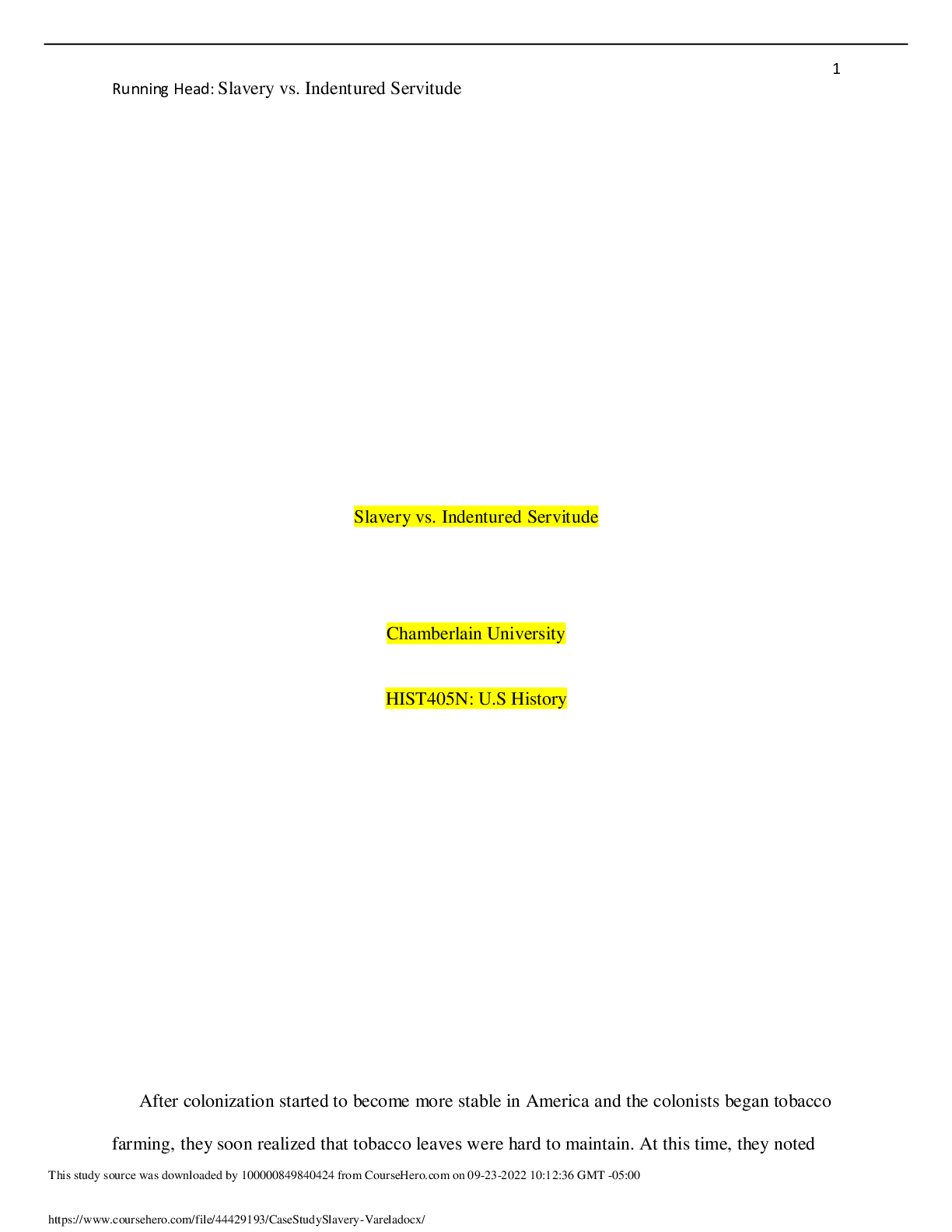

.png)

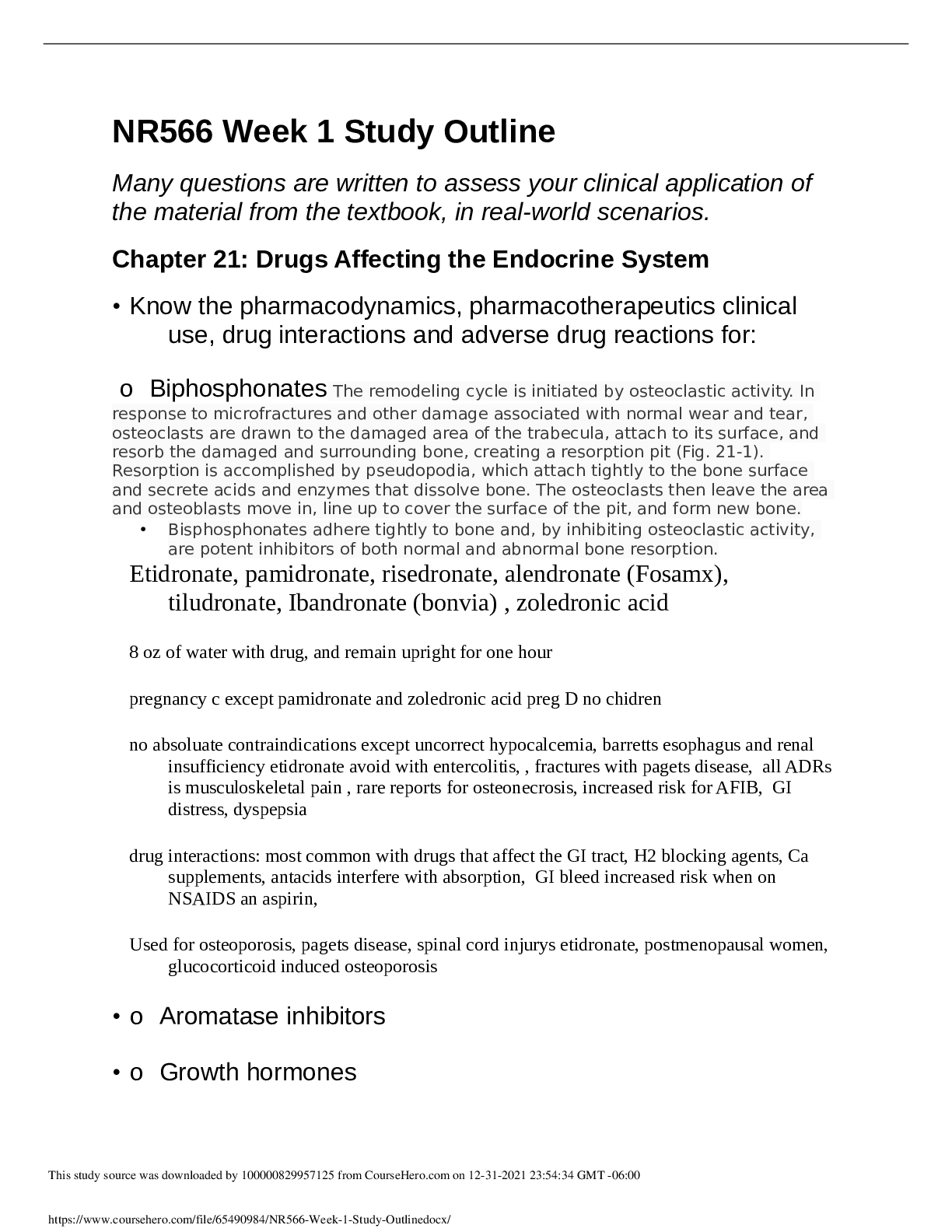



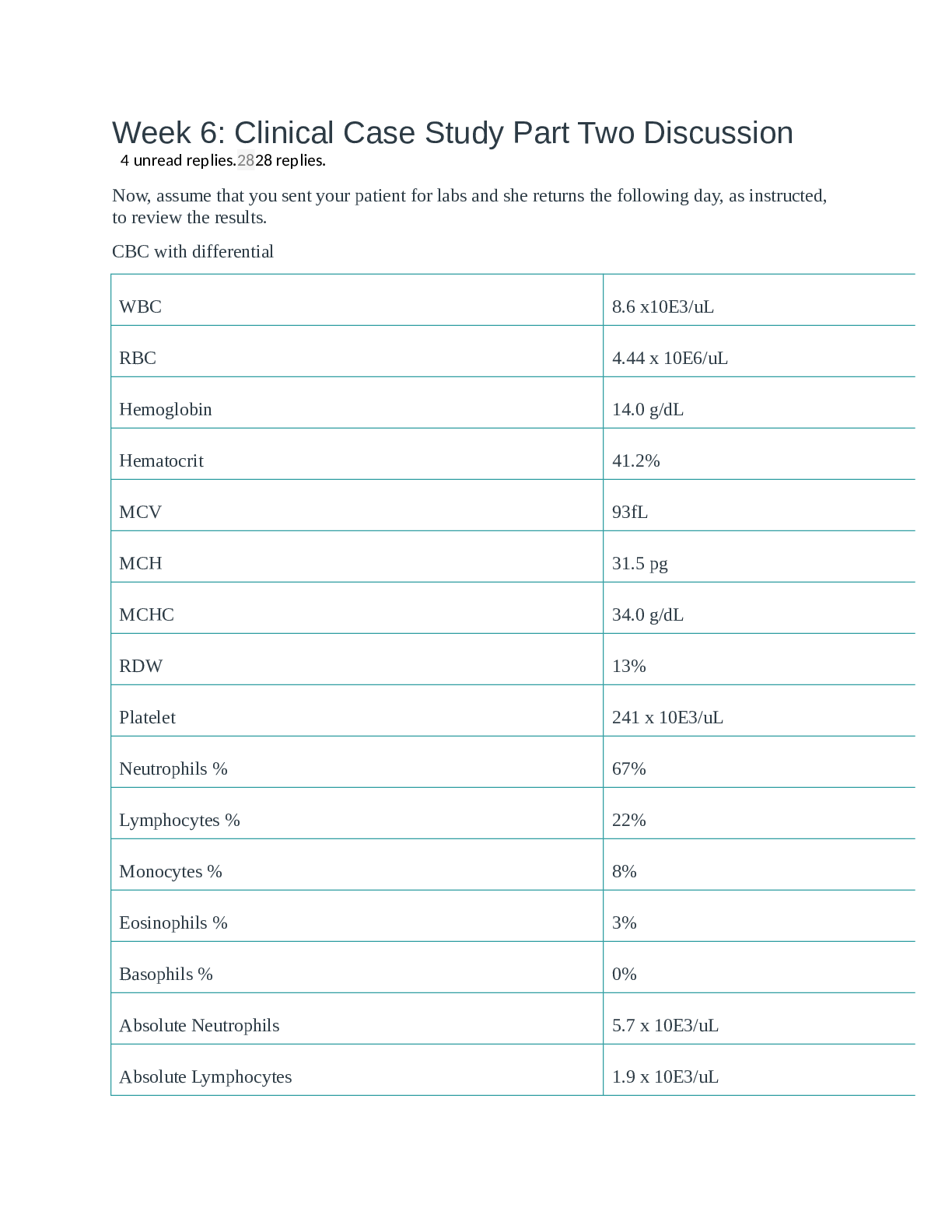

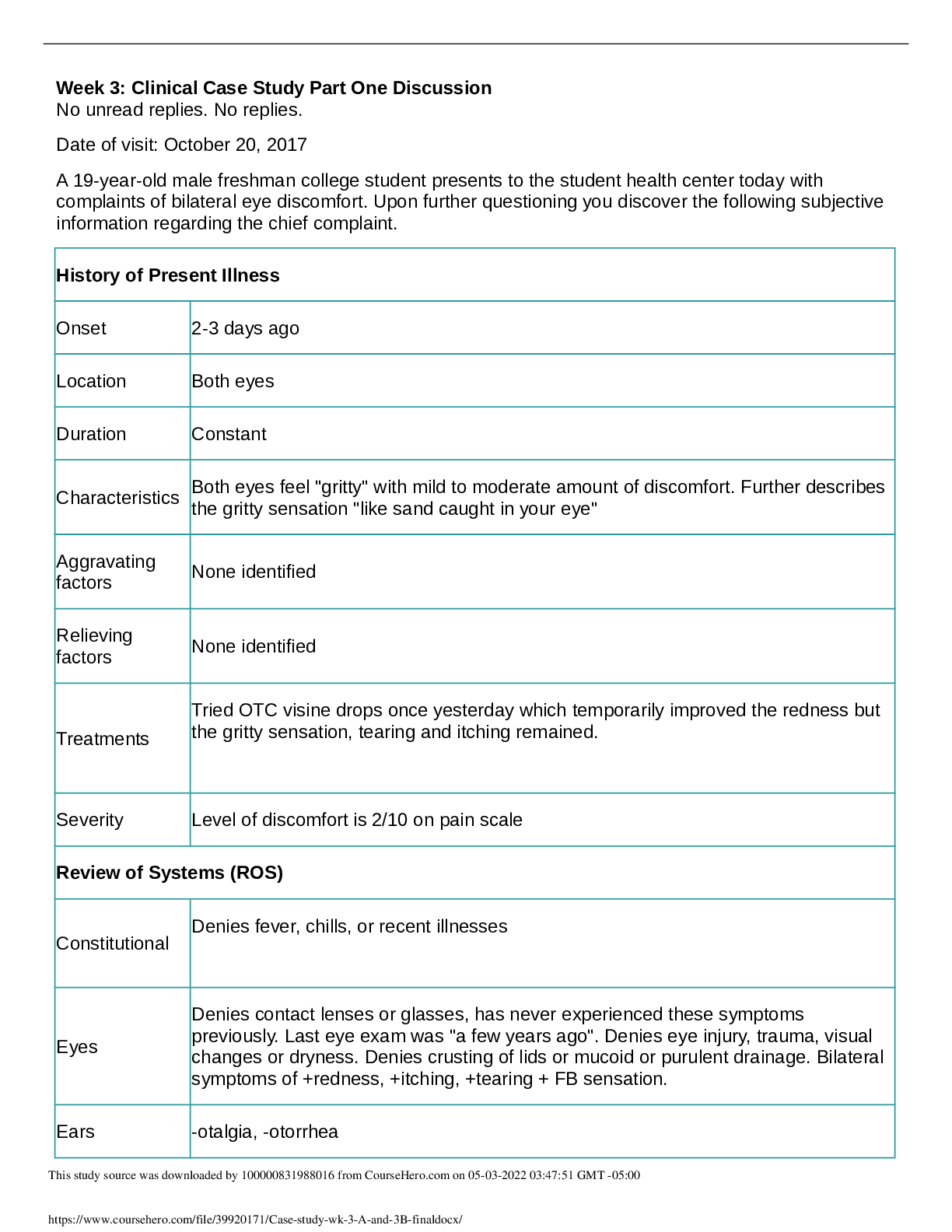
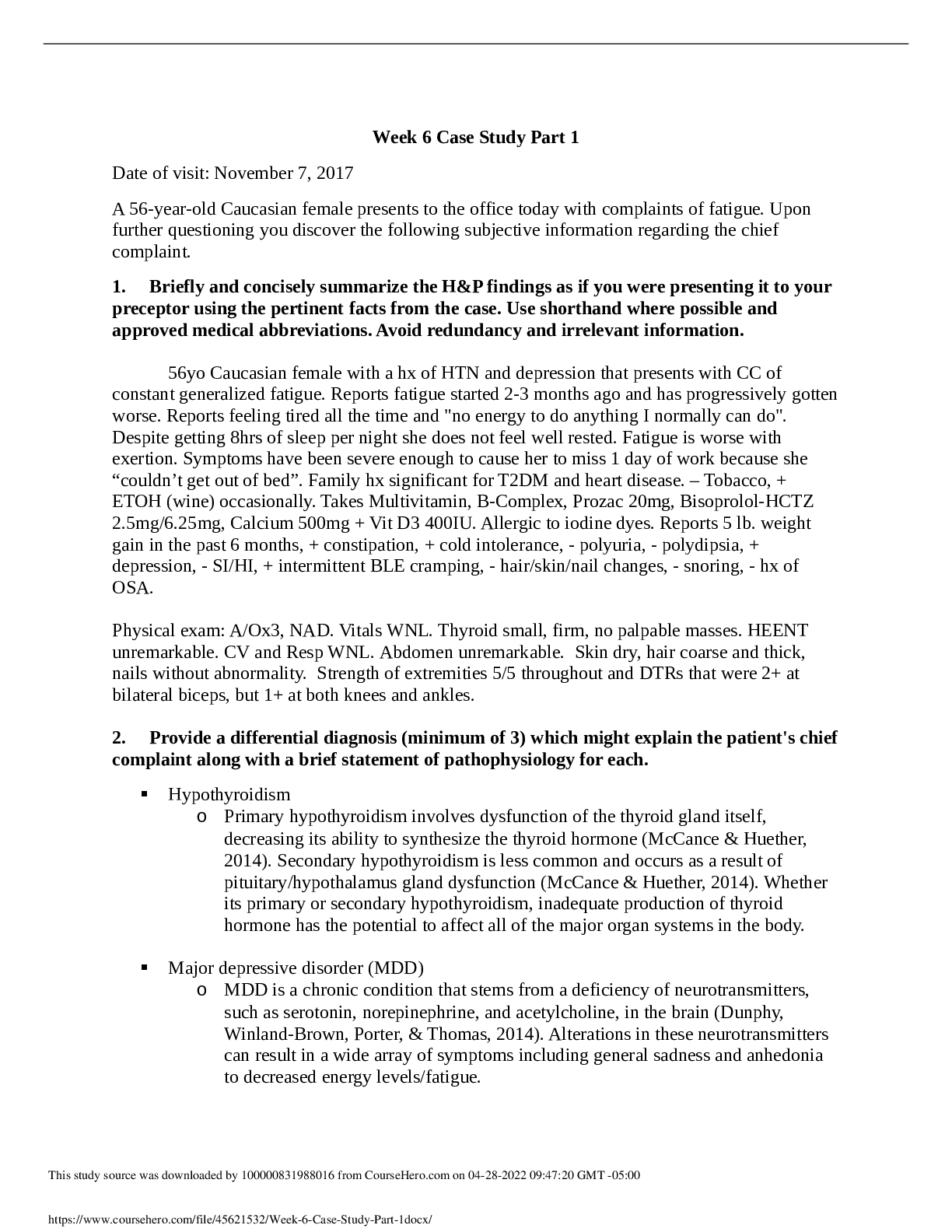
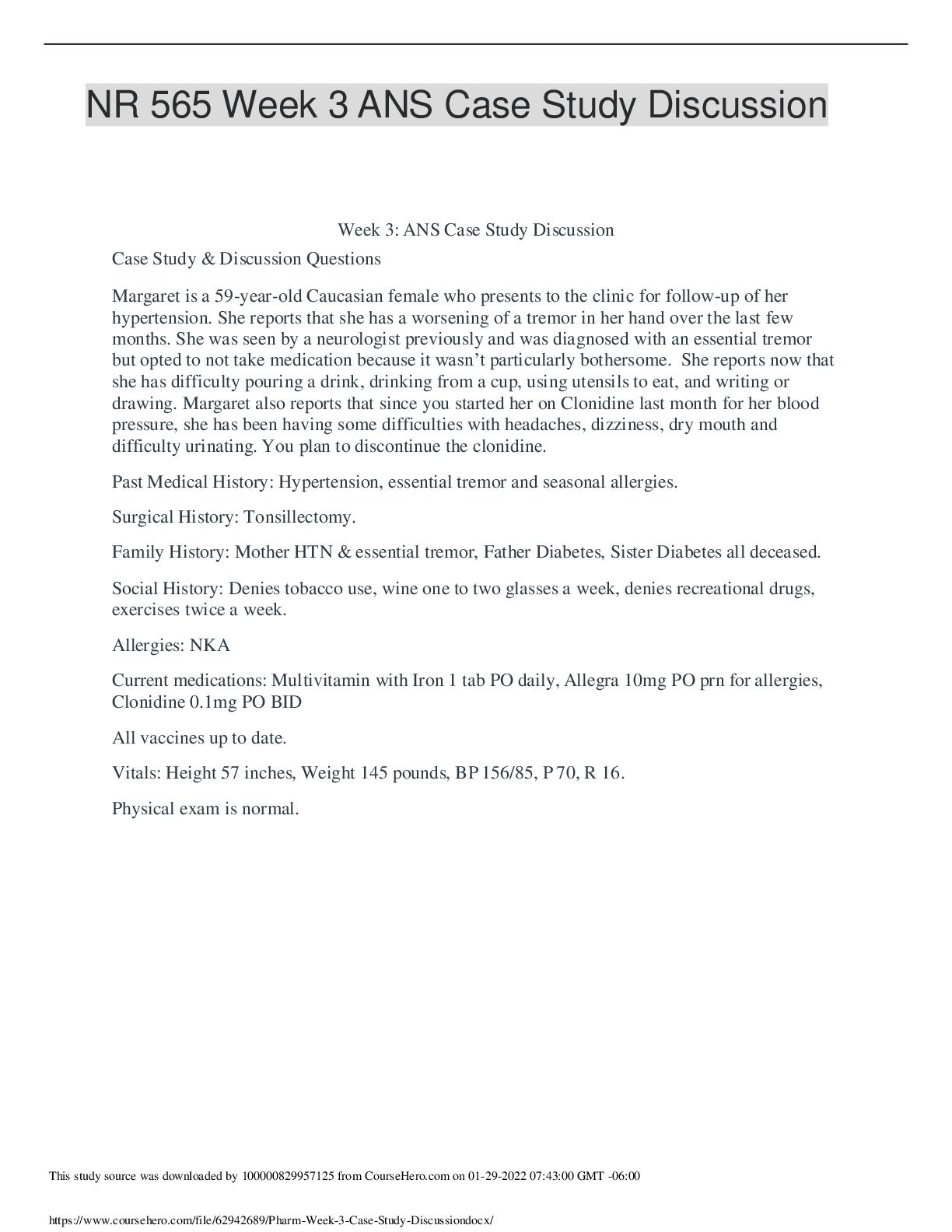
.png)
.png)
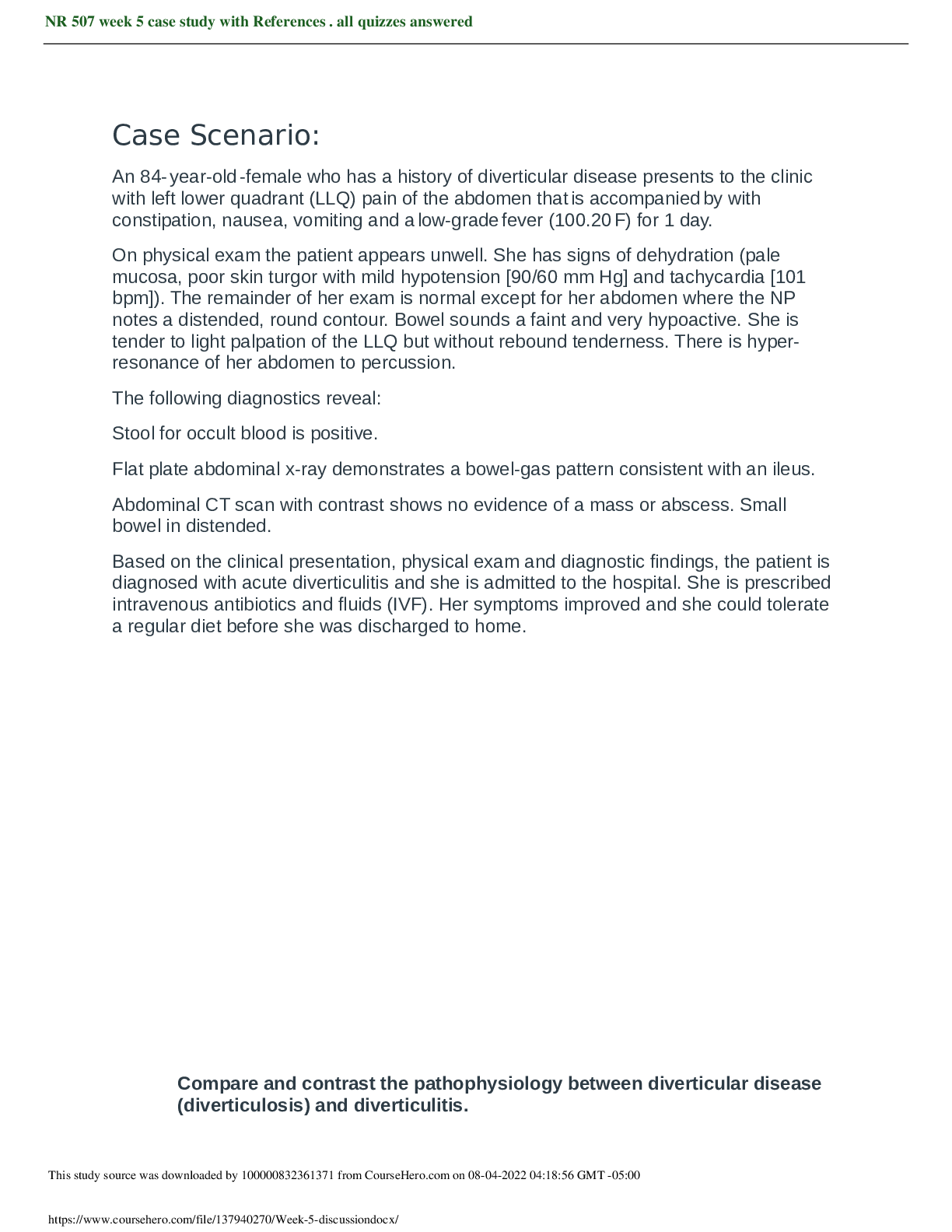
.png)
